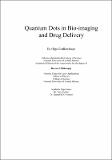| dc.description.abstract | This work explores a range of bionanomaterials, with particular attention to their influence on cell growth, function and fate. Also the issue of intracellular nanoparticles quantification has been addressed in experimental and model approach. Ternary V-VI-VII semiconductor material SbSI has been investigated for its capacity to replace existing convenient II-VI CdTe, which is commonly used for engineered Quantum Dots (QDs).
It remains unclear how QD uptake and cell fate are influenced by QD parameters such as size, composition, coating, concentration, and time of exposure. We have investigated experimentally and theoretically the toxic effects of intracellular QDs on RAW264.7 cell line. We have performed comprehensive study of QDs uptake dynamics and kinetics by monocyte/macrophage cells in physiological media conditions depending on particles size, composition, concentration, and exposure time using flow cytometry as quantification method. Number of cellular and immune responses was measured at the same time by multi-color approach. Was profiled the distribution of live, necrotic, early and late apoptotic cells under different experimental conditions. Pro-inflammatory surface markers CD80/86 were profiled as macrophage activation parameter. Flow cytometry has been shown as quick unbiased evaluation method of ingested particles on population level. We explained sudden drop in surface markers expression related to QDs uptake and cell function profile. The model parameters enabled a convenient quantitative evaluation of the toxicity of the various types of QDs, and good agreement was found between theoretical and experimental results.
We have developed water-based ultrasonic synthesis of micro-scale SbSI particles to bring it down to submicro level. Also was made successful attempt to control crystal growth of particles with various dimensions were obtained. As-prepared micro- and sub-micro crystals were broken down to nanoparticles with broad absorption. The potential cytotoxicity of different fractions was tested on RAW264.7 monocytes. | en_IE |


